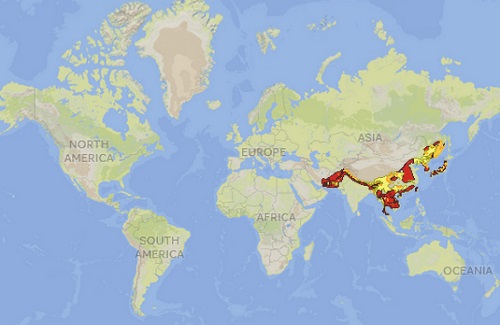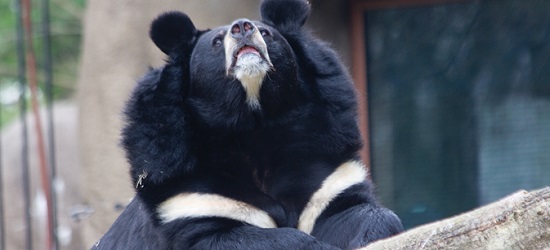Taxonomy
Kingdom |
Phylum |
Class |
Order |
Family |
Genus |
Species |
| Animalia | Chordata | Mammalia | Carnivora | Ursidae | Ursus | Ursus thibetanus |
0
0
Name
- Common Name: Asiatic black bear, Asian black bear, Himalayan Black bear, Tibetan black bear, moon bear.
- Scientific Name: Ursus thibetanus
Distribution and Habitat
- The Asiatic black bear has a wide distribution. Its range covers southeastern Iran, Afghanistan, Pakistan and through the Himalayas to Myanmar. It also covers Southeast Asia to southern China, southern Russian Far East, North Korea and South Korea. Its distribution extends to the southern islands of Japan and Taiwan.
- Habitats of the Asiatic black bear include coniferous and temperate forests.
- They live at higher elevations during summer and at lower elevation during winter.

Asiatic Black Bear Distribution Map. Red areas show where the species is currently extinct. Source: IUCN Red List of Threatened Species.
Physical Features
- The Asiatic black bear is covered in a black coat and has a white-yellow “U” shape patch on the chest. They are known as moon bears due to this marking.
- Its tail is usually covered under its long coat.
- Its ears are larger than other species.
- Like other bears, the Asiatic black bear has a developed sense of smell but a poor eye sight and hearing.
- They have relatively small claws but are good climbers. They spend most of their time foraging high in the tree canopy.
Length and Weight
- Asiatic black bears measure 4 to 6 ft or 1.2 to 1.8 m in length.
- Males weigh from 242 to 330 lbs or 110 to 150 kg.
- Females weigh from 143 to 198 lbs or 65 to 90 kg.
Behavior
- Asiatic black bears are solitary animals unless is breeding season or a female raising cubs.
- These bears can be both diurnal and nocturnal animals. They are nocturnal in habitats where there is human activity.
- In colder climates Asiatic bears hibernate during the winter months. In warmer climates they enter a rest period which is not considered true hibernation. In Russia where winters are the coldest they enter their dens in November and leave in April or May.
- During hibernation Asiatic bears experience a drop in heartbeat and body temperature.
- Asiatic black bears have a home range that ranges from 6.5 to 35 sq km. Its length depends on density and availability of food.
- They mark their territory by leaving scent marks, droppings and spraying urine in rocks and trees.
Diet
- Diet depends on habitat.
- They are classified as carnivores like other bear species however they have an omnivorous diet which includes mostly vegetation and fruits.
- Their diet consists of seeds, fruits, plants, acorns, walnuts and other nuts. They also eat termites and ants and occasionally birds or rodents.
Reproduction
- They reach reproductive age when they are 4 or 5 years old.
- Breeding peaks in the summer months of June and July. They breed every 2 to 3 years.
- Gestation lasts from 6 to 8 months and are believed to have delayed implantation. The fertilized embryo implants the uterus at a later date when conditions are right.
- The female builds a den where she will give birth.
- Litter size is 1 to 4.
- Cubs are born in the den between March and April.
- Cubs are born hairless and are weaned when they are 6 months old.
Life Expectancy
- In the wild they live up to 25 years.
- In captivity they can live more than 30 years.
Threats
- Natural predators are tigers, brown bears and wolves.
- Habitat loss, degradation and fragmentation due to logging, human settling and industry.
- Poaching of Asiatic bear parts for traditional medicine is fuelled by growing demand in the Asian market.
Conservation Status
- The IUCN Red List of Threatened Species lists the Asiatic bear as a vulnerable species.
- It is protected by CITES Appendix I.
- In China they are under class 2 of China’s Wildlife Protection Law.
- In India they are under Schedule I of the Indian Wildlife Act.
Related Species
 |
 |
 |
 |
| Bear, Andean or Spectacled |
Bear, Asiatic Black |
Bear, Black | Bear, Brown |
 |
 |
 |
 |
| Bear, Giant Panda | Bear, Polar | Bear, Sloth | Bear, Sun |
References and further research
IUCN Red List of Threatened Species
Denver Zoo – Asiatic black bear
University of Michigan Museum of Zoology – Ursus thibetanus Asiatic black bear
World Association of Zoos and Aquariums WAZA – Asian black bear (Ursus thibetanus)
ITIS Report – Ursus thibetanus

